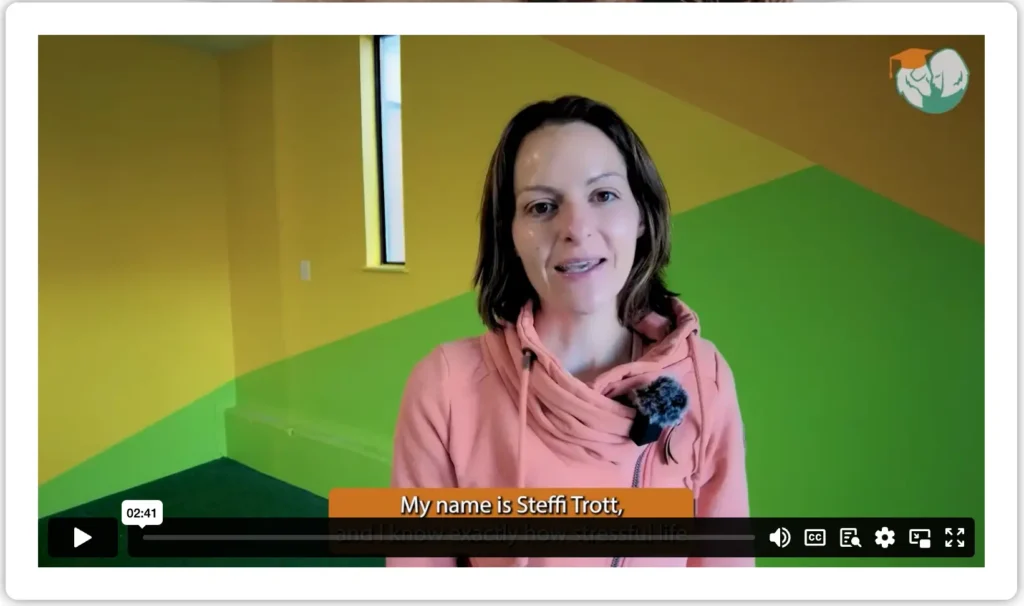
The Red Zone: Your reactive dog can’t think clearly at all
What to do if your reactive dog is in the red zone?
- Simply get out of their as quickly as you can
- Do not yell at or otherwise punish your dog
- Be prepared to provide several decompression opportunities over the next few days
- Remember that these things happen — you are not a bad owner
- Reflect on the situation and consider what you can learn for next time

Your reactive dog’s ideal mindset is in the green zone. Whenever possible, they should be able to sniff, take your treats, follow your cues right away and keep their leash completely relaxed. A reactive dog that is far enough from their threshold does not look reactive at all. This is important to keep in mind! You should not push your dog to have an explosive response.
If your dog is in the yellow zone of the reactivity chart, they may still be able to train relatively successfully. Small amounts of stress are not counterproductive. The key here is the word “small” – your dog should still be able to take treats from you. They should not be straining towards the trigger.
A dog in the orange zone in our reactivity chart is just moments away from “blowing up”. This is not a state of mind in which your dog can make new, positive memories. All they are going to remember is the stress. You should get out of there while you still can!
Finally, a dog in the red zone has escalated their reaction. They are not able to respond to or even acknowledge any cues from the hander. They are lunging, barking and might even consider to bite if pushed too far.


Why Is My Dog Becoming More Reactive?
Are you noticing your dog's reactivity worsening over time? Perhaps you've attempted various methods to decrease their reactive behaviors, but they appear to escalate and “lose control” more rapidly than before. This could be because your dog is spending excessive time in the orange zone of our reactivity scale.
Watch out for these signs:
- Tense posture
- Inflexible tail (possibly erect or even wagging)
- Unbreakable gaze
- Inability to respond to simple commands (like their name, Come, or Sit)
- Pulling hard on the leash
- If these behaviors are common during walks, your dog is overly stressed to improve their reactivity. Repeatedly exposing them to such situations will only intensify their reactive tendencies.

Reactive dog training
It’s not easy (or cheap) to find a local dog trainer that specializes in reactive dogs. That’s why I recommend, Spirit Dog’s Tackling Reactivity Online Course.
Tackling Reactivity is a self-paced online course that will step you through training your dog. Steffi explains in detail the why, what and how of reactive dog training.
With videos and loads of graphics, it’s easy to follow. If you are committed and consistent, you will see drastic changes in your dog’s behavior rather quickly.
A huge bonus with the Tackling Reactivity Course is that you can send in videos of your dog for personalized help! How amazing is that!
Tackling Reactivity can help dogs that are reactive in the car, reactive towards people in your home, reactive in the yard and fence line, reactive to sounds, and more.
It’s not an overnight cure by any means. And it does take a big commitment on your part. You will need to change your old habits and your routine.
But isn’t your dog worth it?

Due to their breed-specific traits, reactivity can develop rapidly, often leaving owners feeling overwhelmed when it comes to addressing the issue.
How To Use Your Dog Reactivity Chart
You should not use dog reactivity chart until after you have completed the Tackling Reactivity Course or met with a local reactive dog trainer, and fully understanding and tracking all the triggers your dog may face.
When walking your dog, bring the chart and monitor their reactivity. Keep them in the green and yellow zones. If they approach the orange zone, immediately retreat from the trigger.
In busy areas, it can be challenging to use the reactivity chart effectively. Choose off-peak hours for walks when fewer people are out. For dogs with severe reactivity, walks may need to be suspended temporarily.
The most effective way to address reactivity is through controlled sessions. Arrange to meet a friend with their dog in an open space, or choose a park or trail where you can maintain distance from other dogs. Approach triggers from afar, offering treats and allowing ground sniffing. Ensure the leash remains loose and your dog stays relaxed.
Refer to your reactivity chart: Is your dog still in the yellow or green zone? If not, increase the distance from the trigger. This is crucial for long-term improvement in their reactive behavior.

In conclusion – to react or to not react
Start by finding a local reputable dog trainer that specializes in reactive dogs. or check out the Reactive Dog Training course.
So, what choice will you make? Are willing to try anything to help bring your dog out of their suffering of reactivity for both your sakes?
Learn more about the Spirit Dog’s Tackling Reactivity Online Course. With the course, you get instant access, personal trainer support, all with a 60 day unconditional money back guarantee. So what are you waiting for, you having nothing to loose and everything to gain!